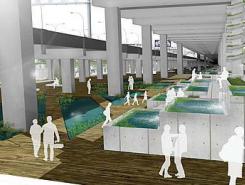
A proposal for the Central Corridor Eco-District. Rendering by Jihee Chung, SWA Group.
Over the last year, there’s been palpable buzz in San Francisco around eco-districts — essentially, sustainability plans that operate at the neighborhood scale. We’ve learned about different eco-district models and how eco-districts are working in Portland, Seattle, Brooklyn and Denver. The San Francisco Planning Department has been especially proactive in this learning process, putting together numerous presentations on district-scale infrastructure and sustainability throughout 2012. The largest of these meetings, held last August at SPUR, kicked off a planning process for an eco-district in the Central Corridor of San Francisco. This 24-square-block area south of Market Street, centered around 4th Street, is currently undergoing a neighborhood planning and rezoning process to better manage and support growth around the new Central Subway.
What’s the buzz about? In areas of transition like the Central Corridor — once an industrial area and increasingly the home of the city’s high-tech sector — neighborhood rezoning creates many opportunities for new development. Some of this will be private development on sites within the corridor, and some will be public investment in transportation assets, water, wastewater, energy and neighborhood parks. The Central Corridor Eco-District was conceived to help the transitioning neighborhood perform well on the city’s environmental goals for greenhouse gas reductions, zero waste, water conservation and efficiency, stormwater management, renewable energy, transportation and more.
In a city where neighborhood edges are somewhat blurry, why focus on sustainability at this scale instead of an “all-of-the-above, everywhere” approach? After all, many of the city’s environmental goals make the most sense when implemented wherever possible and feasible. For example, SF has a rule requiring all residents to compost and recycle; as a result the city is well on its way toward achieving its zero waste goals. Properties in the Central Corridor surely will comply, and perhaps even innovate to exceed our current citywide waste diversion rate of 78 percent. But there is little magic to the boundary around the Central Corridor in accelerating our progress on this goal. Similarly, cooperation between properties is unlikely to boost energy efficiency upgrades, which are typically performed within the building envelope.
But at the neighborhood scale, some things stand out as real possibilities to accelerate sustainability. In these cases, proximity to a specific project or opportunity — and to property owners interested in making it happen — could make all the difference. A neighborhood-scale focus can bring two unique opportunities to the cause of sustainability:
1.

Leave a Reply
You must be logged in to post a comment.